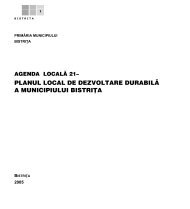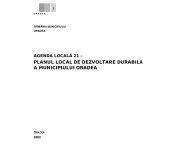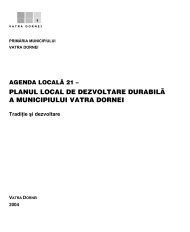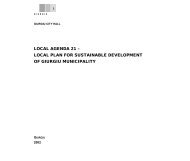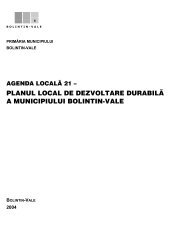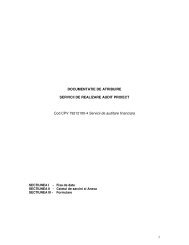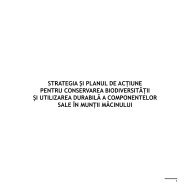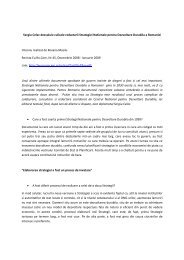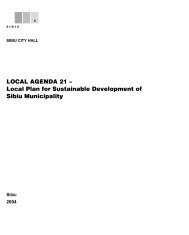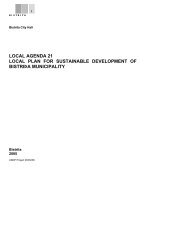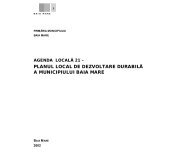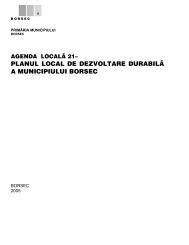English Version - United Nations Development Programme Romania
English Version - United Nations Development Programme Romania
English Version - United Nations Development Programme Romania
You also want an ePaper? Increase the reach of your titles
YUMPU automatically turns print PDFs into web optimized ePapers that Google loves.
Encouragement, stimulation and support for those who wish to become involved in the management<br />
and sustainable use of the soil;<br />
Supporting sustainable use of farmland by special programmes aimed at small agricultural activities,<br />
which represent a major source of food for the rural population and serve as product supply for urban<br />
markets.<br />
All these aspects must be integrated in a national programme of sustainable management and use<br />
of land, with well-established objectives and terms and be materialised in national and regional projects<br />
such as:<br />
Improving the national research system in the areas of soil science and agricultural chemistry, to<br />
gain detailed knowledge of the country’s farm and woodland resources and of the manner in which<br />
they can be best protected, improved, and used in a sustainable manner;<br />
Implementation of a national geographic infrastructure to improve the knowledge and management of<br />
farm- and woodland resources;<br />
Updating the national monitoring system, in order to survey, assess, predict, warn and intervene<br />
operationally, with the purpose of preserving the quality of farm- and woodland;<br />
Updating the national database on farmland quality, reforming the national information system in this<br />
field;<br />
Introduction of expert systems to maximise the use of the productive capacity of certain types of soil,<br />
without permanently damaging their quality or the environment.<br />
Collecting knowledge of natural potentials and establishing the best ways of using land, including<br />
those from areas and regions with special soil problems (eroded, arid, halomorphic and chemically<br />
polluted soils, soils damaged by strip mining, with water in excess located in meadows or flood plains<br />
and the Danube Delta, etc). All such solutions must satisfy economic and environment protection<br />
requirements.<br />
Ecological rehabilitation of farmland.<br />
30<br />
4.5 Biological diversity<br />
Having its legal basis established since 1930, when the first law to protect the natural monuments<br />
was passed, the study and the protection of the natural capital in <strong>Romania</strong> saw a steady development until<br />
The <strong>Romania</strong>n Black Sea Coastline<br />
The <strong>Romania</strong>n Black Sea coastline, with a length of about 243 km, is currently affected by an<br />
intensive and continuous degradation caused by marine erosion. The shoreline is shrinking at an annual rate<br />
varying from a few meters to 15-20 meters for the coastline of the delta (between Sulina and Cap Midia)<br />
and around 0.2-0.5m for the coastline with sea cliffs (Constanta-Vama Veche).<br />
Erosion along the coastline is both natural and man-made. From among the human activities of great<br />
impact on the situation of the coastline one may mention the hydro-technical works on the Danube and its<br />
main tributaries, the ports, and coastal engineering works. The hydro-technical changes performed on the<br />
Danube and its main tributary have caused a fall in the inwash of sediments in the coastal area by over 50%, as<br />
compared to the values registered before the building of the dykes. Thus, a great sedimentary imbalance has<br />
been created in the coastal zone, which has in turn initiated the erosion process. The port facilities and other<br />
technical coastal engineering works such as the protection dykes for the Sulina navigation channel, the<br />
breakwater piers of the Midia, South Constanta and Mangalia ports, the coastline protection works on the<br />
tourist beaches, which also cause large environmental imbalance along the littoral.<br />
Tendencies. Considering the global climatic changes and the general rise in the sea level, as well as<br />
the regional geo-ecological conditions that characterise the Danube - Danube Delta - Black Sea geo-system,<br />
one can estimate that the medium-term erosion process will be at least as active as in the past two decades. The<br />
long-term predictions reveal an extension of beach erosion, especially because of the continuous decrease of<br />
sand material in the coastal area, because of the permanent rise in the sea level and an ever-higher energy level<br />
of the hydro-meteorological factors.<br />
Prevention of littoral erosion. Many countries consider the problem of losing land by erosion of<br />
their coastline to be of national importance. Beach erosion leads to territory loss, but it especially compromises<br />
the tourist industry, causing significant losses to national economies. The process of erosion also disturbs at<br />
times the ecological state of the coastal area almost irreversibly.<br />
the 1960s, thereafter falling into neglect and being completely abandoned in the 1980s. A few years after<br />
1990, the conservation activity experienced a revival. The Danube Delta Biosphere Reserve was<br />
established, several international conventions regarding the conservation of the biological diversity were



